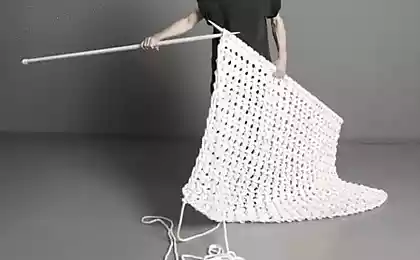877
Knitted electronics: a framework for future smart clothing
Today wearable electronics is the usual gadgets made of plastic and metal, tiny enough that they could fit in the form factor of hours or points. Further miniaturization will sooner or later lead to the fact that the electronic device can be integrated directly into clothing. One of the obstacles along the way - the conflicting requirements for connecting electronic components. On the one hand, the clothes should be soft and supple, with another - metallic conductors quite poorly tolerate the constant stretching and bending. Scientists and engineers have come up with ingenious ways to weave conventional conductors in fabric or create a wire, which in themselves are well stretched, for example in the form of thin tubes filled with liquid metal .
In Hong Kong Polytechnic University investigated very simple way of creating flexible electronic circuits, which allows you to integrate the fabric durable and reliable electrical connections without any tweaks. This method - the good old knitting.
With automatic knitting machine scholars wove copper wires in polyurethane insulation pieces in knitted fabric. Three-dimensional structure of the loops formed by knitting, very well suited for the protection of thin wires from excessive point loads. Samples withstand extreme tension up to 300%, and with typical household loads up to 20% are able to withstand one million cycles of tension and compression. Knitted electronics also withstand 30 cycles delicates in a standard washing machine - without visible deterioration.
Mechanical properties of knitted electronic circuits noticeably superior to other known methods for the integration of electronics into clothing. Such schemes can be used in sports medicine, clothing for work in hazardous conditions. For example, scientists have created a kevlar vest embedded in a network of sensors that determine the place of falling bullets and force of impact. All 35 samples of "smart" protective body armor plates with integrated sensors have been successfully tested, in spite of the extreme loads.
The experimental setup with the "smart" bulletproof jacket i>
Source: habrahabr.ru/post/236609/
In Hong Kong Polytechnic University investigated very simple way of creating flexible electronic circuits, which allows you to integrate the fabric durable and reliable electrical connections without any tweaks. This method - the good old knitting.
With automatic knitting machine scholars wove copper wires in polyurethane insulation pieces in knitted fabric. Three-dimensional structure of the loops formed by knitting, very well suited for the protection of thin wires from excessive point loads. Samples withstand extreme tension up to 300%, and with typical household loads up to 20% are able to withstand one million cycles of tension and compression. Knitted electronics also withstand 30 cycles delicates in a standard washing machine - without visible deterioration.
Mechanical properties of knitted electronic circuits noticeably superior to other known methods for the integration of electronics into clothing. Such schemes can be used in sports medicine, clothing for work in hazardous conditions. For example, scientists have created a kevlar vest embedded in a network of sensors that determine the place of falling bullets and force of impact. All 35 samples of "smart" protective body armor plates with integrated sensors have been successfully tested, in spite of the extreme loads.
The experimental setup with the "smart" bulletproof jacket i>
Source: habrahabr.ru/post/236609/
Sega has created an interactive sandbox for shopping and gaming halls
Mars Rover Curiosity: fun has just begun























